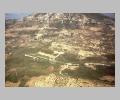
Triton column capitol (c. 2nd Century B.C.E.), Messene.

View of the gymnasium at Messene, Messene.

View to Ithome, Messene.
| Summary: | One of the best fortified of ancient Greek cities. |
| Type: | Fortified city |
| Region: | Messenia |
Periods:
Classical
Hellenistic
Roman
Physical:
Located in the highlands of Messenia on the SW slopes of Mt. Ithome, Messene was among the best fortified of ancient Greek cities. Mt. Ithome was mentioned by Homer and its summit served as a religious center and refuge for the Messenians at least since the Archaic period. From the acropolis almost all of the state of Messenia is visible.
The 4th century B.C. fortification walls of Messene (still well preserved) totaled a length of ca. 9 km and enclosed the acropolis as well as large tracts of agricultural land that could serve as a place of refuge for inhabitants from the countryside. A Sanctuary of Asklepios, theater, stadium and other public buildings were also enclosed within the fortifications. The circuit walls (ca. 2.5 m thick and 4.5 m high) included at least 4 well-designed city gates and over 30 towers.
Description:
The city of Messene was founded as the new capital in 369 B.C. after the liberation of Messenia from Spartan rule, and the city walls are reported to have been completed in just 85 days.
Messene joined and abandoned a number of leagues and alliances during the Hellenistic period and was besieged in 220, 214, 202, and 182 B.C. The city was never politically powerful, but remained prosperous and continued to be inhabited at least into the 5th century A.D.
Exploration:
Minor excavations by T. Sophoulis in 1895; G. Oikonomos in 1909 and 1925. A. Orlandos has excavated from 1957-1964 and since 1969.
Sources Used:
Other Bibliography:


